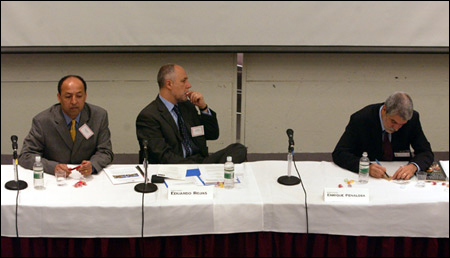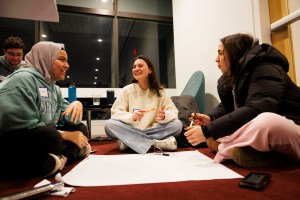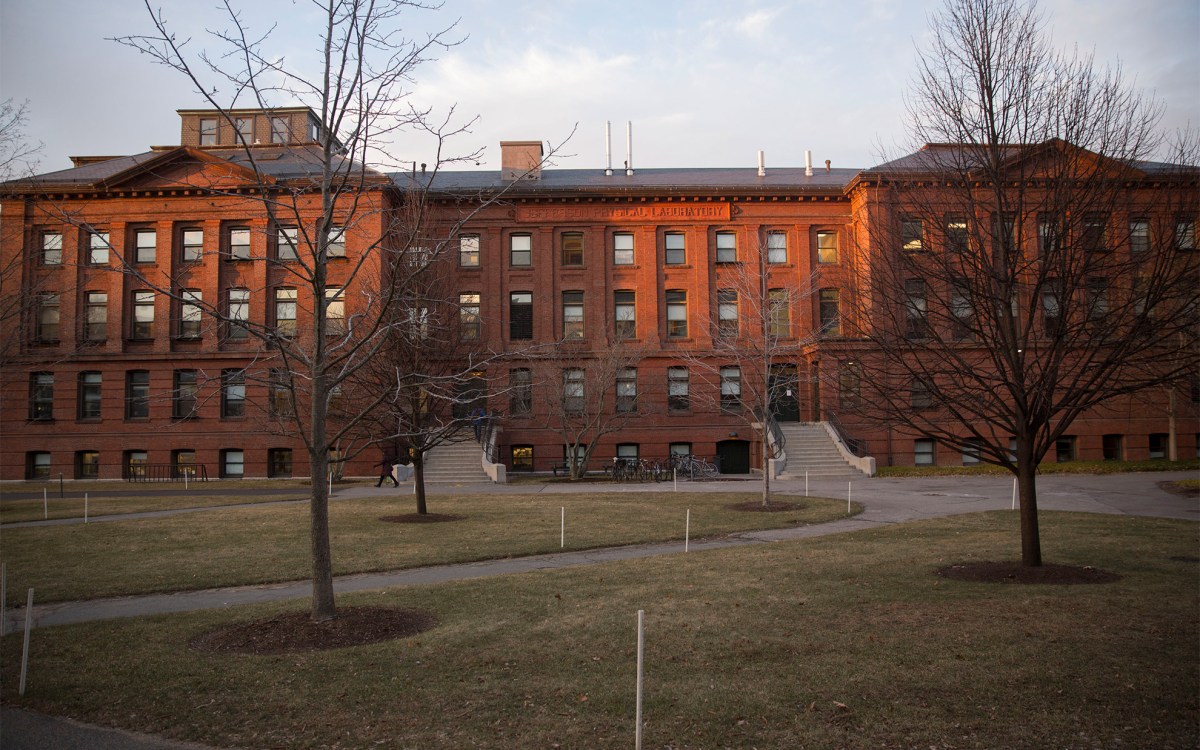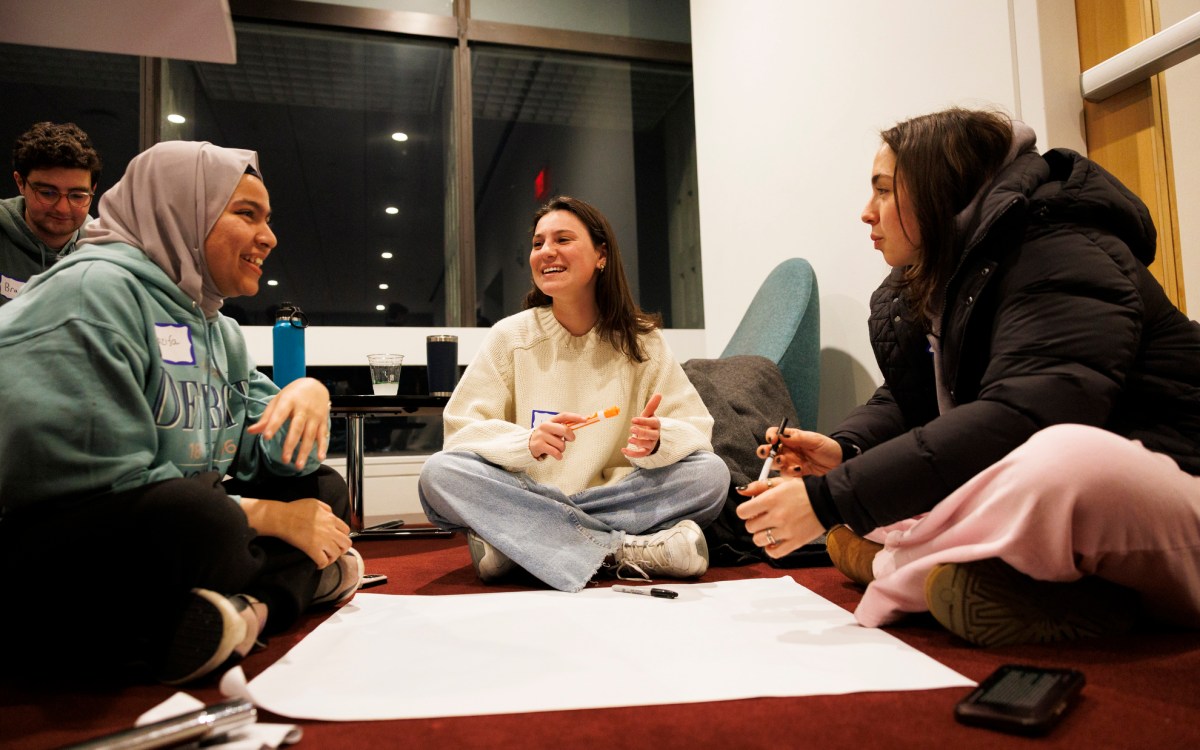In Bogotá, don’t park on the sidewalk:
Making the city people-friendly

Toward the beginning of his three-year term as mayor of Bogotá, Colombia, Enrique Penalosa was nearly impeached.
Did he have an affair with an intern? Lie under oath? No, he tried to keep cars off the sidewalks.
The fact that he escaped impeachment, and more important, managed to ban cars from the sidewalks despite the squawks of protest from business owners accustomed to using pedestrian walkways as their designated parking areas, speaks volumes about Penalosa’s effectiveness as a municipal reformer.
Penalosa, a tall man with salt-and-pepper hair and a booming voice, spoke April 2 as part of a symposium at the Graduate School of Design (GSD) called “Building on the Past: Strategies to Support Culture in Sustainable Development.” Many of the presentations focused on buildings and monuments and how these cultural assets could attract tourist traffic, yet be integrated into the fabric of the city in beneficial ways.
Penalosa began his illustrated talk on an apologetic note. His presentation followed that of Dimitris Avramopoulos, former mayor of Athens, and Penalosa made it clear from the outset that Bogotá is hardly in the same class as the ancient Greek capital. In fact, pre-Penalosa Bogotá was something of a basket case.
“People thought it was a punishment of God to live in Bogotá. They hated the city. When I was campaigning, people would tell me, this place is beyond remedy. Nobody can do anything about it.”
Bogotá’s problems were numerous – drugs, crime, corruption, traffic congestion, pollution, and a crumbling infrastructure. But rather than attempt a wholesale renovation of Colombia’s capital, Penalosa concentrated on doing things that would build identity, pride, self-esteem, and positive communal values.
One of Penalosa’s first targets was the automobile. In addition to blocking sidewalks, motor vehicles had been allowed to run rampant in this city of more than 7 million people, creating pollution, noise, and daily traffic jams. As a first step, Penalosa declared a car-free day, requiring all citizens, rich and poor, to share the sidewalks on an equal footing.
“It was a ceremonial occasion, a carnival of social integration.”
Penalosa followed up on this event with other measures designed to promote equality and respect for human dignity. Among these was the “Ciclovia,” similar to the “Take Back the Night” marches in American cities, in which citizens of Bogotá traveled the dark streets by bicycle and on foot in order to “collectively conquer the night, to conquer fear.”
The bicycle became a powerful symbol of the empowerment of poorer citizens during Penalosa’s administration, with the mayor himself conspicuously riding a bike to work.
“This raised the status of bicycles. No one wanted to ride bikes before because they were associated with poor people.”
Other projects aimed at making the city more respectful of human beings included parks, bike paths, pedestrian streets, a new bus system, new schools, libraries, free concerts, and firework displays.
“People often think of things like Christmas lights and fireworks as a waste of money, but these things create a sense of belonging and they construct memories that people will carry with them to their deathbed.”
Children were a major focus of the mayor’s efforts. He built 50 new schools, designed by top architects and prominently sited in order to convey a message that children are important.
Another priority was the construction of public spaces.
“High quality public space is a symbol of respect for human dignity. It is during leisure time that income differences are felt most painfully. For the poor, enjoying public space is the only alternative to television.”
Enjoyment of public spaces satisfies what Penalosa called “happiness needs,” which include “the need to be with others and to have contact with nature.”
He also focused on the need for aspirations, “to construct a shared vision of what the city should be.” From the point of view of culture, he said, “it may be as important what people aspire to be, to have, or to do, than what they actually are or have or do.”
Located on a high plateau on the eastern side of the Andes, Bogotá has a cool, moist climate that some inhabitants find depressing, but Penalosa found a way to put a positive spin on the city’s geography with the slogan: “Bogotá, 2,600 meters closer to the stars.”
Penalosa’s efforts seem to have paid off. Crime has declined significantly, and there is a noticeable shift in the mood of the city.
“In three years, the citizens’ image of the city and their relation to it has changed dramatically,” he said. “People have begun to care for the city. They have pride and a sense of belonging.”
One of Penalosa’s last slides showed a path in one of Bogotá’s renovated parks lined with towering royal palms. His comment emphasized the pride that Bogotá’s inhabitants are beginning to feel for their unique city.
“We can never have Notre Dame or the Parthenon, but we can have an avenue of giant tropical trees that Paris or Athens can never have.”




